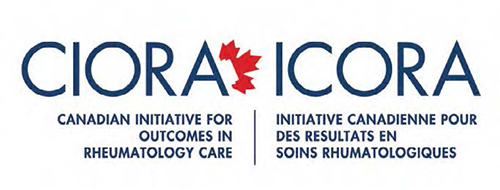Summer 2019 (Volume 29, Number 2)
Update from CIORA
By Janet Pope, MD, MPH, FRCPC
Download PDF

CIORA has funded 92 grants and provided $6,375,982
in research funding; 48 grants in Awareness/Advocacy/
Education, 23 grants for Multi-Disciplinary Care
Teams, 20 grants for Early Access for Rheumatic Disease Patients
and 1 in Health Economics/ Sustainability of Health
Care/Quality Improvement, which was a category newly
created in 2018. There are important insights from recent
grants, as discussed below.
“Understanding the barriers to self-management support
for underserved populations living with arthritis
and co-morbidities and developing patient-derived
tools for healthcare policy and practice”
This research will integrate knowledge translation from a
range of different health professionals and policy makers
to collaborate on the design and implementation of the
study. This process is instrumental in the understanding of
barriers faced by musculoskeletal disease populations and
should result in policy changes. (Principal Investigator Dr.
D. Lacaille).
“Measuring geographic variation in access to care for
rheumatoid arthritis patients and related outcomes: A
patient-centred approach”
This project will translate results about health services use
and cost, and the geographic variability of quality of care
and outcomes, into recommendations. (Principal Investigators
Drs. D. Marshall and C. Barber).
“Quality of referrals to pediatric rheumatology in Northern
Alberta and its effects on access to care”
This study has importance for triage and education. Triage
of referrals by the pediatric rheumatology team at the University
of Alberta teaches residents how to prioritize and
triage. It facilitates knowledge regarding a good referral letter.
As a result of data collection, evidence will be gathered
for targeting physicians who refer to pediatric rheumatology
to educate them around best referral practices. (Principal
Investigator Dr. M. Chan).
“Assessing the provision, patterns, and costs of waiting
for rheumatology care: a step towards optimizing the
care of rheumatic diseases”
This project draws attention to inequitable access to care
across regions. Two thirds of the rheumatology patient population
are female; thus, inequitable access to care disproportionately
affects women. The research also quantified
large rheumatology practice volumes, exceeding those of
family physicians. The finding that fewer new patients are
being seen annually is of particular importance because it
implies rheumatology practice sizes (caseloads) are saturated.
Thus fewer new patients are being seen, which contributes
to increasing wait-times and reduced access to care.
Gender differences in clinical activity and remuneration
(incomes) between female and male rheumatologists were
identified. On average, female rheumatologists provided
fewer assessments and saw fewer patients annually relative
to males, which resulted in lower earnings. With more women
in rheumatology, this has consequences for the calculation
of the optimal number of rheumatologists. (Principal
Investigators Drs. B. Kuriya, S. Bernatsky, and J. Widdifield).
Janet Pope, MD, MPH, FRCPC
Professor of Medicine, Division Head, Division of Rheumatology,
Department of Medicine, St. Joseph’s Health Care,
Western University
London, Ontario
|
